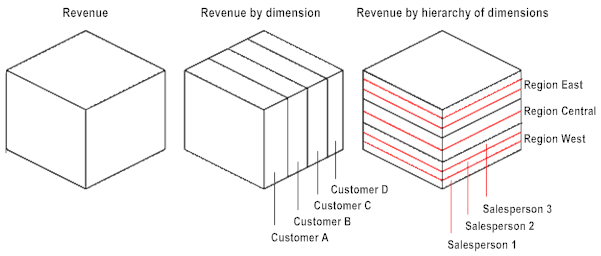Dimensions
Measuring a metric like revenue or queue length by itself often does not provide all the information needed to analyze business or system performance. For example, an organization may want to measure:

Revenue by region and sales person in addition to total order revenue

Queue length by broker
To facilitate measuring more complex metrics, Optimize uses the concept of dimensions. A dimension is a category, a way to analyze business or system data by slicing it into smaller components. Because dimensions are arbitrary and business-specific, organizations must define their own dimensions. Typical examples are:

Customer

Region and sales person

Product and manufacturer
 Broker Server
Broker Server and
BrokerTo understand the concept of a dimension, think of a metric like revenue as a cube. See the “KPIs and Dimensions” figure below.
Now imagine slicing that cube into layers based on customers. The resulting slices enable you to measure revenue by customer.
Another way to slice the cube is by region and sales person. The resulting slices enable you to measure revenue by region and by sales person within each region.
KPIs and Dimensions
A KPI can measure business or system data by slicing it into dimensions. In the examples above, you might have a Revenue by Customer KPI and a Revenue by Region and Sales Person KPI. For system data, you might have a Queue Length by Broker Server and Broker KPI.
To analyze business or system data by slicing it into multiple dimensions such as region and sales person, you must arrange dimensions within a hierarchy.
A hierarchy is an ordered ranking of dimensions. A hierarchy provides additional ways to slice data into smaller components. For example, a sales hierarchy might consist of two dimensions: region and sales person. A queue length hierarchy might also consist of two dimensions: Broker Server and Broker.
Organizations define their own hierarchies of dimensions. For example, one organization might have a product hierarchy in which manufacturer is the main category and product name is a sub-category. Another organization might have a product hierarchy in which product name is the main category and product manufacturer is the sub-category.
